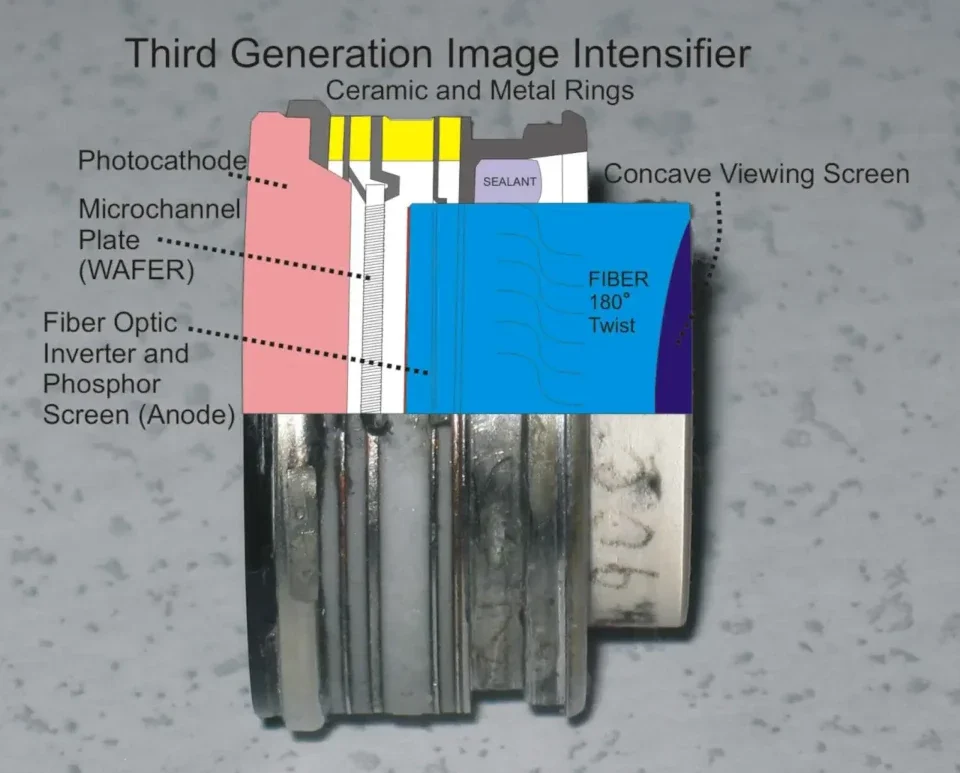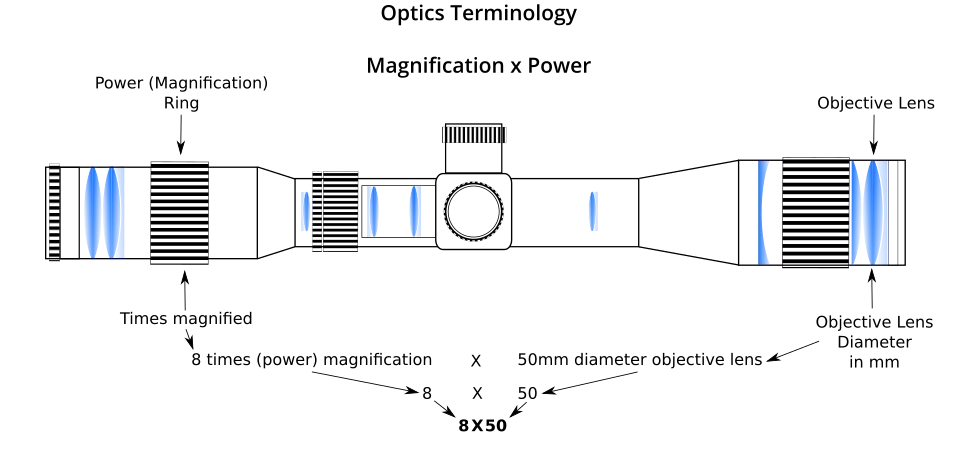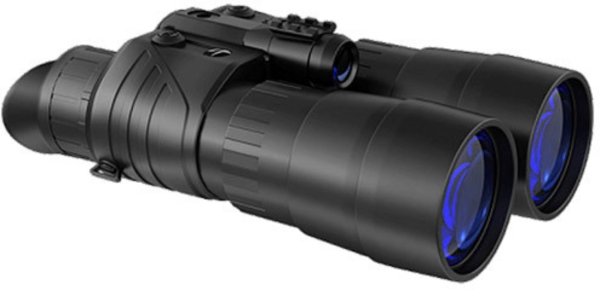

Night Vision
Night Vision is about being able to see in low light conditions and if eating carrots are not doing it for you then perhaps night vision devices will help.
Table of Contents
Night Vision is the ability to see in low light conditions, not no light conditions. The human eye can be of use in low light environments, being able to pick out large objects and some movement. Not particularly useful when hunting. So the development of optoelectronic devices that enhances our vision in low levels of light is welcome indeed and will be the main focus of this article.
Description
The human eye has three defined ranges of adaptation which correspond to the way we see. Photopic, Mesopic and Scotopic. They refer to the light sensitive cells of the of the eyes retina. We will discuss two of these cells called cones and rods.
Cones
Cones come in three flavors, (sorry, couldn’t help the pun), long-wavelength (red), medium-wavelength (green), and short-wavelength (blue). These cells give us color vision and fine visual acuity. They are gathered most densely at the center of the retina.
Cones are mostly active at mid to high levels of light. As the light level decreases the cones reduce activity and as a result it becomes difficult to discern fine detail and also color.
Rods
Rods cover everywhere but the eyes center and their coverage of this area is greater than cones. They give us peripheral vision and are great at picking up movement.
Rods become active at low to mid light levels, taking over from the cones.
As rods are more populous at the eyes edge, it explains why we can see better in low light using our peripheral vision.

Scotopic Vision
Scotopic refers to the vision provided by rods. As we said, once light drops below a certain level, the only active cells are rods. Therefore, our ability to see color is lost. This is why everything under moonlight appears black and white.
When scotopic vision is not good enough for hunting, that is when we turn to technological enhancements such as night vision devices (NVD’s).
Night Vision Devices (NVD's)
Night vision devices are an optoelectronic device that allows visualization of images in low levels of light. The devices enhance visible light and uses image intensification to turn multiple wavelengths of low level light into a single wavelength of visible light.
The core component of a NVD is a vacuum tube called an image intensifier.
Image Intensifier
What this tube does is grab photons of light from the objective lens of the device. It then converts the photons into electrons, amplifies them, then turns them back into photons. The amplified photons are then presented to the viewers eye via the ocular lens as the familiar glowing green image.
Green was chosen as the image color as it was the easiest to view over long periods of time. The unit is typically powered by small AA or N-cell batteries.

History
The first night vision devices appeared just prior to World War Two with a Hungarian physicist inventing an electronic tv camera (Evaporograph) that was sensitive to infrared light waves. Kalman Tihanyi was working for the British Air Ministry in 1929 when he developed the camera to be used in anti-aircraft defense.
Early image intensifiers were used by both sides during WW2.
Night Vision by Generation
Generation 0 Night Vision
The first generation night vision developed prior to the end of WW2 is considered as generation 0 night vision devices. The materials available at the time did not amplify the light enough to be really effective so they were used in conjunction with and infrared light source.

Generation 1 Night Vision
This generation had better photocathode materials available. That and the advent of fiber optics allowing multiple intensifier tubes to be connected in a “cascade”, meant the first real viable starlight scopes became available. These scopes were truly “passive” and used in Vietnam.
Approximate light amplification = 1,000
I used the 2nd model of the Starlight Scope, a AN/PVS-2. It was a massive thing to be sitting atop a rifle and not really very clear some distortion thrown in.
Generation 2 Night Vision
This generation saw the introduction of the micro-channel plate (MCP) which resulted in a far brighter image and consequent improved clarity.
Approximate light amplification = 20,000
Generation 3 Night Vision
Generation 3 devices have a better image, better performance in low light, about 30% better than Gen 2. Readily available in todays units.
Approximate light amplification = 30,000 – 50,000
Generation 4 Night Vision
Generation 4 technically does not exist due to the generation ceasing to be made due to problems with very fragile tubes. They are more correctly Gen 3 thin film devices. But who cares if they are referred to as Gen 4? The devices are extremely clear and their performance in low light is next level.
Hard to get and very expensive currently, but it is the ducks guts.
Wide Field of View
Humans have a field of view (FoV) with two eyes of 190° whilst a typical NVD has a FoV of 40°. There are technologies that increase this:
- Panoramic night vision
- Foveated night vision
- Diverging image tube night vision
but are mainly used by the military in goggles.
Magnification
Magnification refers to how much the target image has been enlarged. For instance, an object seems eight times closer with a 8 x 40 binocular than it would be without one. The objective lens’s diameter is indicated by the number that comes right after the “x” in millimeters. A 8 x 40 binocular has a 40mm objective lens and a 8 x magnification.

Night vision simply does not have the resolution of a normal daytime optic. Increases in magnification rapidly degrade the image quality, therefore the magnification on any NVD is limited.
Night Vision Pros and Cons vs. Thermal Vision
Pro's
- Cheaper
- More natural image
- Wider Field of View
- Smaller and Lighter
Con's
- Useless in daylight
- Fog, dust and smoke obscures the image
- Targets can be obscured by scrub or grass
Summary: Night vision is cheaper than thermal vision as well as lighter and smaller. NVD’s are an ashtray on a motorbike in highly lit environments and can’t penetrate scrub and airborne impediments like thermals.
Australian Rules and Regulations
Night Vision Devices are legal in Australia. However states have their own regulations on the use of NVD’s. New South Wales does not allow the use of NVDs when hunting in their state forests and Victoria classifies NVDs as spotlights and there are hunting restrictions applicable.
Night Vision Devices
Hunting with night vision devices have increased markedly as prices have come down. Hunters are quick to reap the benefits this tech can offer.
FAQ (Frequently Asked Questions)
How does night vision work?
Night Vision is the ability to see in low light conditions, not no light conditions. Optoelectronic devices enhance visible light via image intensification. This process turns photons of light from the objective lens of the device into electrons. It then amplifies the electrons and turns them back into photons which are presented to the viewers eye via the ocular lens.
Is night vision legal in australia?
Night vision and Night Vision Devices (NVD’s) are legal in Australia. However states have their own regulations on their use. Some states do not allow the use of NVDs when hunting on certain public lands and some put NVDs in the same class as spotlights and are likewise restricted for same circumstances.
According to the Australian Customs and Border Protection Service, it is illegal to import night vision devices without a permit. Permits may be granted for the import of night vision devices for certain purposes, such as scientific research, education, and testing.
What is the difference between first and second generation night vision?
First generation night vision devices use a vacuum tube called an image intensifier to amplify light, while second generation devices use a microchannel plate in place of the vacuum tube. Second generation night vision is generally considered to be of higher quality and performance than first generation, as it is more sensitive to light and produces a clearer, brighter image.
Can you use night vision in complete darkness?
Some night vision devices, such as those with a built-in infrared illuminator, can function in complete darkness. The infrared illuminator projects a beam of infrared light that is invisible to the naked eye but can be detected by the night vision device, allowing it to function even in the absence of any other light source.
How far can you see with night vision?
The distance at which you can see with night vision can vary depending on a number of things, such as the type of NVD, the amount of light available, and the size and contrast of the target. Night vision simply does not have the resolution of a normal daytime optic. Increases in magnification rapidly degrade the image quality, therefore the distance on any NVD is going to limited. You can expect to see farther with a higher quality (read more expensive) night vision device than an el cheapo special from Amazon.
Photo Credits: Pulsar


